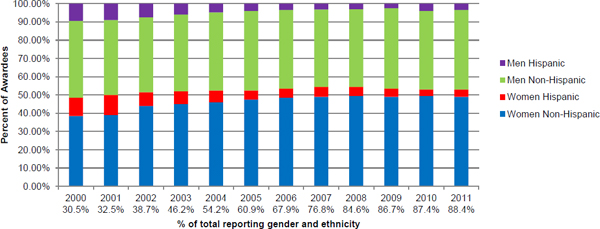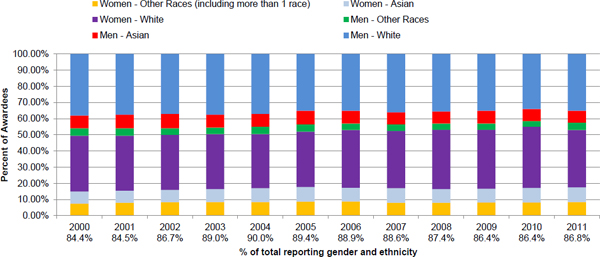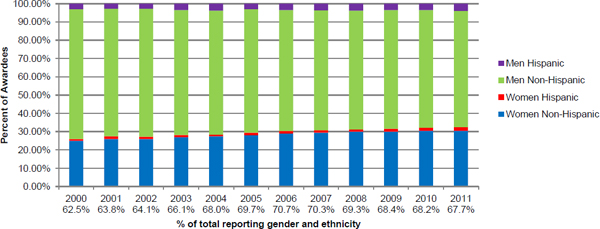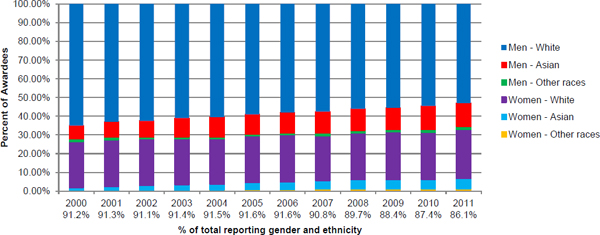As the largest supporter of biomedical research in the United States, the National Institutes of Health (NIH) seeks fundamental knowledge about biological systems to advance health and reduce the burden of disease. Achieving this mission requires continuous input of creativity and innovation from the nation’s most talented scientists. Maintaining biomedical workforce diversity is vital to ensure participation of the most talented individuals from all groups, as well as to ensure commitment to broad research priorities, address health disparities, and enhance recruitment of diverse subjects into clinical research protocols.38
Underrepresentation of Women and Minorities in Biomedical Research
Despite growing recognition of the importance of diversity in the research workforce, troubling discrepancies remain. Women and minorities are underrepresented in the biomedical workforce, especially in leadership positions. At the intersection of these two categories, women of color face challenges at all stages of the educational and professional pathway leading to a research career. From early education through graduate and postgraduate studies, tenure track, and beyond, women of color can face a staggering array of obstacles. While they share subsets of these challenges with other women and men of color, others are unique. Their extreme underrepresentation can be associated with feelings of isolation and a scarcity of role models and culturally competent mentors. It can also result in repeated and excessive requests to serve on committees, due to low overall minority representation. Some women of color feel caught in a “double bind,” pressured to align themselves with either women or with minority groups, rather than embracing their whole identities.39 To address challenges experienced by women of color, there must be efforts to identify and eliminate institutional and organizational biases that impede success.40
How do women of color fare at the NIH? According to the National Science Foundation, underrepresented minority women earn approximately 0.3% of doctorate degrees in science and engineering.41 Based on the Association of American Medical Colleges 2011 medical school graduates self-identified data, 8.5 percent of graduates were Black or African-American women,
__________________
38 NIH Health Disparities Strategic Plan and Budget Fiscal Years 2009-2013: www.nimhd.nih.gov/about_ncmhd/NIH%20Health%20Disparities%20Strategic%20Plan%20and%20Budget%202009-2013.pdf.
39 Malcom, S.M., Hall, P.Q., Brown, J.W. “The Double Bind: The Price of Being a Minority Woman in Science.” AAAS Report 75-R-3. April 1976.
40 Obiomon, P.H., et al. (2007). “Advancement of Women of Color in Science Technology, Engineering and Math (STEM) Disciplines.” Retrieved from www.nyu.edu/frn/publications/advancing.women/Adv.%20Women%20in%20Stem%20Tickles.html.
41 National Science Foundation, Division of Science Resources Statistics. “Women, Minorities, and Persons with Disabilities in Science and Engineering: 2011.” Special Report NSF 11-309. Arlington, VA. 2011.
7.8 percent were Hispanic women and 0.8 percent were American Indian women.42 Of the Federal workers employed by the NIH in scientific or technical positions for General Schedule (GS, GM, GP, or GR) grades 13 through 15, which are the higher grades, Black, Hispanic, and American Indian/Alaskan Native women make up 4.61 percent, 1.41 percent, and 0.21 percent respectively.43
Trends in NIH awards to trainees, fellows, and researchers were evaluated over fiscal years (FYs) 2000 to 2011. The data are shown in Figures E-23-1 to E-23-4.44 For this report, the results are presented by self-reported gender and race (White, Asian and Other Races (including Black, American Indian or Alaska Native, Native Hawaiian or Other Pacific Islander, and persons reporting more than one race), and gender and ethnicity (Hispanic versus non-Hispanic). The results presented in graphs include only persons reporting both gender and race, or gender and ethnicity – they exclude those for whom any of these demographic characteristics was unknown or withheld. To provide perspective, the graphs also show the percentage of the total population that appears in the graph because they reported both gender and race, or gender and ethnicity.
Overall, women, Hispanics and underrepresented race groups comprised a higher proportion of NIH-funded trainees and fellows than researchers. Despite slight gains over the last decade, women reporting to be Hispanic or from underrepresented race groups represented a small fraction of the trainee and fellow pool, and an even smaller portion of the researcher pool.
NIH Trainees and Fellows: Trends in Gender and Race, and Gender and Ethnicity
In 2000, men trainees and fellows were slightly more prevalent than women. By 2011, this trend reversed. For the subset of trainees and fellows reporting both gender and race, women from underrepresented racial groups remained constant at 6% to 7%, whereas both Asian and White women increased slightly over the time period evaluated. Men from underrepresented racial groups remained constant at 4% and comprised a smaller fraction of trainees and fellows than women from the same racial groups. (Figure E-23-2).
From 2000 to 2011, the proportion of trainees and fellows reporting their ethnicity greatly increased over 2000 to 2011, from 30% in 2000 to 88% in 2011. This shift was likely linked to the onset of collecting ethnicity and race status separately, which NIH began in 2001. Subsequently, those identifying as Hispanic grew from 6% to 9% from 2000 to 2011, while those reporting they were not Hispanic grew more rapidly, from 25% to 81%. For those reporting gender and ethnicity, the proportion of Hispanic women decreased relative to the proportion of non-Hispanic women; however, these relative differences were due to increases of persons reporting ethnicity, with most of them identifying as non-Hispanic. Within the total population of trainees and fellows, including the subset which did not report their gender and/or race, the percentage of Hispanic women actually increased slightly from 3% to about 5% in 2011. (Figure E-23-1)
NIH Research Awardees: Trends in Gender and Race, and Gender and Ethnicity
From 2000 to 2011, among NIH funded researchers, men were more highly represented. Women researchers made gains over this time period, growing from about a quarter to a third of
__________________
42 Association of American Medical Schools, Table 29: Total US Medical School Graduates by Race and Ethnicity within Sex, 2002-2011, www.aamc.org/data/facts/enrollmentgraduate/, accessed May 29, 2012.
43 Source: NIH Data Warehouse as of 3/24/12
44 Source: NIH Office of Extramural Research, Division of Information Services
the total. The proportion of underrepresented race groups was about 2% in 2000, increasing slightly to about 3% in 2011. The proportion of White awardees declined from 80% to 68%, offset by increases in those identifying as Asian or not reporting their race. The percentage of research awardees reporting Hispanic ethnicity was about 3% in 2000, and increased slightly to about 4% by 2011. The percentage of those reporting as non-Hispanic rose from 60% to 64% in the same time period, due to a higher proportion of researchers reporting ethnicity status.
• Among NIH Research awardees reporting both gender and race (Figure E-23-4):
o In 2000, men researchers identifying with an underrepresented race group were 1.4% of the awardees, whereas women from those same groups constituted 0.8% of awardees. By 2011, these proportions increased to 1.8% for men and 1.4% for women. White men awardees declined from 65% to 53% from 2000 to 2011, offset by relatively large increases for Asian women and men, and smaller gains by White women.
• Among NIH research awardees reporting both gender and ethnicity (Figure E-23-3):
o There were about half as many Hispanic women as Hispanic men, representing a small proportion of those reporting and grew very slightly over time (ranging about 1-2% for Hispanic women and 3-4% for Hispanic men).
Addressing Disparities in the NIH Peer Review Process
An NIH-commissioned study examining NIH competing research and training awards in 2008 found that women generally performed as well as men, but men were more successful on renewal type 2 grant applications.45 NIH also commissioned an analysis of how race or ethnicity affects the probability of an applicant receiving an R01 grant.46 This study revealed that R01 applications from self-identified minorities were less likely to receive funding when compared to applications from White investigators. High scoring grants were equally likely to be funded, regardless of the race or ethnicity of the investigator, but applications from minority investigators received lower scores. While discrepancies in grant funding for Hispanic and Asian investigators were explained by confounding factors, no identified variables explain the considerably lower funding rates for Black investigators. Even after controlling for education and training, employer characteristics, previous awards, publication record, and country of origin, Black applicants were ten percentage points less likely to receive funding than White investigators. NIH views these findings as a call-to-action to the biomedical research community.
Why do White applicants fare better in the NIH review process? One possibility is that White applicants have greater access to mentors and other resources that affect the quality of grant applications. A more disturbing possibility is that minority applicants face bias in the grants review process. NIH is using experiments and further analyses to evaluate the review process and identify areas that might be influenced by conscious or unconscious bias.47 To address these issues, NIH has created internal and external task forces charged with examining diversity issues and advising the NIH Director on decisive action. The Diversity Working Group, chaired by NIH Deputy Director, Dr. Lawrence Tabak is part of the NIH Director’s Steering Committee. The Diversity in Biomedical Research Working Group of the Advisory Committee
__________________
45 Pohlhaus, J.R., Jiang, H., Wagner, R. M., Schaffer, W. T.,, Pinn, V.W. Sex differences in application, success, and funding rates for NIH extramural programs. Academic Medicine. 86: 759-767. 2011.
46 Ginther, D.K., Schaffer, W.T.Schnell, J., Masimore, B., Liu, F., Haak, L.L., Kington, R. Race, Ethnicity, and NIH Research Awards. Science. (333)1015-1019. 2011.
47 Tabak, L.A. and Collins, F.S. Weaving a Richer Tapestry in Biomedical Science. Science. 333: 940-941. 2011.
to the Director is an external panel of experts, chaired by Dr. Tabak, Dr. John Ruffin, Director of the National Institute of Minority Health and Health Disparities, and Dr. Reed Tuckson, Executive Vice President and Chief of Medical Affairs, United Health Group. This group has held public meetings and issued a Request for Information seeking public input. Their recommendations are due in June 201248. Further, the NIH Deputy Director for Intramural Research has formed senior advisory committees to analyze recruitment, retention, and promotion of women and minorities in the Intramural Research Program.
NIH has a variety of programs that support women and minorities in biomedical research. A selection of these programs is highlighted here:
The NIH Working Group on Women in Biomedical Careers develops innovative strategies and tangible actions to promote entry, recruitment, retention, and sustained advancement of women in biomedical careers. Under the current leadership of NIH Director Dr. Francis Collins and Office of Research on Women’s Health Acting Director Dr. Janine Clayton, this trans-NIH working group promotes changes to institutional policies in the NIH intramural and extramural communities. Recent outcomes include modifying the biographical sketch section of NIH grant application to allow description of factors contributing to reduced productivity; tenure-clock extension for family leave; increasing paid parental leave for NIH trainees; and instituting a Back-Up Care Pilot Program for short-term care for dependents of NIH employees. Career advancement of women of color researchers is addressed by one of the seven committees of the Working Group, the Women of Color in Biomedical Careers Committee which recently launched WoCRn (www.wocrn.nih.gov), a new social media site for women of color and all interested in diversity in the scientific workforce. The goals of WoCRn include providing information about the NIH grants process, facilitating access to colleagues and mentors, and promoting community among women of color scientists. There are currently over 600 members, from academia, government, and industry. NIH Working Group on Women in Biomedical Careers website: http://womeninscience.nih.gov/index.asp
Research into Underrepresented Groups in Biomedical Research. Current NIH funding initiatives to support diversity research include: the NIH Director’s ARRA Pathfinder Award to Promote Diversity, Research on Causal Factors and Interventions that Promote and Support the Careers of Women in Biomedical and Behavioral Science and Engineering, and the Research to Understand and Inform Interventions that Promote the Research Careers of Students in Biomedical and Behavioral Sciences initiative.
NIH has a variety of programs designed to increase minority participation in biomedical research. The Research Supplements to Promote Diversity in Health-Related Research program uses administrative supplements to support high school, undergraduate and graduate students, postdoctoral researchers, and eligible investigators from groups underrepresented in biomedical research. One example of the impact of these supplements on women of color comes from the National Institute of Biomedical Imaging and Bioengineering (NIBIB), where 76 diversity supplements were awarded to 72 grantees in 2011. 32 of grantees (44.4%) were females, and 94% of these women were minorities. 13 (40.63%) of the women were Hispanic, another 13 (40.63%) were Black, 3 (9.38%) were American Indian/Alaskan Native, and 1 was a Pacific Islander (3.13%). Within the past eight years, Black women received 17% of the diversity supplements and F31 diversity predoctoral fellowships from the Eunice Kennedy Shriver
__________________
48 The report is accessible at http://acd.od.nih.gov/Diversity%20in%20the%20Biomedical%20Research%20Workforce%20Report.pdf
National Institute of Child Health and Human Development. NIH also supports loan repayment programs and an undergraduate scholarship program to help relieve financial barriers to pursuing a research career. Many of the NIH Institutes and Centers have additional programs. For instance, the Minority Access to Research Careers (MARC) program within the National Institute of General Medical Sciences supports mechanisms for underrepresented biomedical and behavioral scientists. The National Cancer Institute manages the Center to Reduce Cancer Health Disparities, supporting multiple programs focused on underserved populations. In many of these programs, women outnumber men. The National Institute of Environmental Health Sciences manages a Scholars Connect Program, providing internships for STEM-focused undergraduates from Historically Black Colleges and Universities, Minority Serving Institutions, and other nearby academic institutions with high minority enrollment. Additional NIH activities that support biomedical workforce diversity can be found within The NIH Health Disparities Strategic Plan: www.nimhd.nih.gov/about_ncmhd/NIH%20Health%20Disparities%20Strategic%20Plan%20and%20Budget%202009-2013.pdf.
In 2011, NIH unveiled the Early Career Reviewer Program. Goals of the program include training qualified scientists lacking significant prior review experience to become effective reviewers, helping emerging reviewers advance their careers by exposing them to the review process, and enriching the pool of NIH reviewers by including scientists from less-research- intensive institutions as well as those from traditional research-intensive institutions. NIH has reached out to a wide range of institutions to solicit nominations for early career reviewers, and has made a special effort to publicize this program to underrepresented minorities. http://public.csr.nih.gov/ReviewerResources/BecomeAReviewer/Pages/Overview-of-ECR-program.aspx
NIH is taking concrete steps to address issues of diversity in the biomedical workforce. Realizing the NIH mission requires the engagement of the best and brightest female and male scientists, from all backgrounds. NIH welcomes the opportunity to collaborate with other stakeholders to comprehensively address these challenges. Increasing representation of women of color in biomedical research requires a multipronged approach to reach women throughout the educational and career pipeline. The following areas could be considered:
• Enhance the quality of science and math education at all levels so that students enter college poised to succeed.
• Develop strategies to support women scientists of color in completion of undergraduate and graduate science degrees. Provide programs to promote successful navigation of critical transition periods.
• Ensure quality mentoring to support career development and mitigate isolation. Provide mentor training that incorporates culturally competent mentoring. Evaluate mentoring, and recognize exceptional mentors.
• Perform research on barriers and effective interventions for women of color in the sciences. Collect and report data, disaggregated by sex and race/ethnicity, to accurately assess the representation of women of color across academia, industry, and government.
• Fight implicit bias with effective training programs informed by evidence.
• Evaluate existing diversity programs to determine their effectiveness. Replace ineffective programs with ones informed by research and proven best practices.
• Form creative partnerships among academia, industry, and government to share best practices and increase access to role models in underrepresented groups.

Figure E-23-1 Self-identified Gender and Ethnicity of NIH Trainees and Fellows, Fiscal Years 2000-2011(Excludes awards funded by American Recovery and Reinvestment Act of 2009)

Figure E-23-2 Self-identified Gender and Race of NIH Trainees and Fellows, Fiscal Year 2000-2011 (Excludes awards funded by American Recovery and Reinvestment Act of 2009)

Figure E-23-3 Self-identified Gender and Ethnicity of NIH Research Grant Awardees Fiscal Years 2000-2011(Excludes awards funded by American Recovery and Reinvestment Act of 2009)

Figure E-23-4 Self-identified Gender and Race of NIH Research Grant Awardees, Fiscal Years 2000-2011 (Excludes awards funded by American Recovery and Reinvestment Act of 2009)







